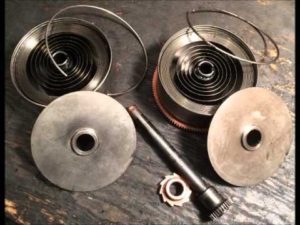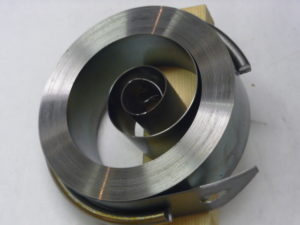THE SPRING MOTOR
When one visits Auburn Valley State Park to tour the Marshall mansion, the Marshall Steam Museum, or Marshall Brothers paper mill a visitor takes a trip back in time exploring living as it was in the late 19th and early 20th centuries. While visitors enjoy the contents of the mansion or a ride in a steam car, they often overlook the backstory that is being told. For example, docents are often asked, “How fast can a Stanley go?” In 1906 a Stanley set the world speed record of 127.6 miles per hour, but that was a special-purpose vehicle. On today’s roads a Stanley has no problem doing 35 MPH while maintaining boiler steam pressure. Visitors will often comment, “that’s slow” as they use today’s modern vehicle speeds as their comparison.
When reminded of the high-crown dirt roads of the early 20th century and that it was the late 1910s before Delaware started thinking about paving rural roads, visitors realize driving at speeds of more than perhaps 10 MPH on those rural roads produced a very bumpy and potentially hazardous travel experience. Horse-drawn carriages and stage coaches might sustain 10 MPH and travel 100 miles in a day depending on road conditions, weight of the coach/carriage pulled, weather, etc. The motor carriage (steam, electric, or internal combustion powered) was an improvement but a long way from what we experience today. Visitors often relate what they see and experience at Auburn Heights to modern interpretation. Once reminded of the backstory present a century ago, an Auburn Heights experience often takes on a whole different meaning.
For the next few months, the Friends of Auburn Heights presents Changing Tunes: Evolution of Music at Home. The exhibit explores the evolving technology that brought music into the home and out onto the street from the 1880s through today. Many of the objects on display are still operational, and at select times on Steamin’ Days and museum open afternoons on Thursdays and Fridays, the musical instruments are demonstrated so visitors may hear how times and tunes have changed.
 In the late 1800s and early 1900s, mechanical music machines were amazing devices and beautiful to listen to, but today the backstory mustn’t be overlooked. These are purely mechanical music-making machines that applied mankind’s most basic understandings of science to produce sound. There are no digital electronics, no batteries, no circuit boards, or similar things we take for granted today. The music is preserved and replayed multiple times through the use of pins on cylinders, holes in paper, or varying width/depth spiral grooves. The “motor” powering the music machine doesn’t require electricity from a wall receptacle or battery.
In the late 1800s and early 1900s, mechanical music machines were amazing devices and beautiful to listen to, but today the backstory mustn’t be overlooked. These are purely mechanical music-making machines that applied mankind’s most basic understandings of science to produce sound. There are no digital electronics, no batteries, no circuit boards, or similar things we take for granted today. The music is preserved and replayed multiple times through the use of pins on cylinders, holes in paper, or varying width/depth spiral grooves. The “motor” powering the music machine doesn’t require electricity from a wall receptacle or battery.
An 1800s music machine contains but few mechanical parts and needed oiling, or other occasional maintenance. Sound is created and amplified in a purely mechanical way from its creation with the pluck of a metal strip or the vibration caused by moving air across a thin strip of metal that resonates. Amplification of recorded sound is afforded by mechanical diaphragms and resonance chambers. A listener is permitted to hear only ‘a’ selection before a change of cylinder, or disk, or roll must be performed to hear the next selection. A listening experience was but a few minutes duration unlike the “set it and forget it” nature of today’s music devices, which provide an “endless music experience.” Ownership in the 1800s of an automated music machine implied the owner to be successful or be from an “old money” family.
Just as mill ponds were the energy source for water wheels powering the mills along the Red Clay Creek, and boilers pressurized with steam suppled energy to steam engines during the magic age of steam, the astute observer will note the mechanical music machines rely on a miniaturized purely mechanical power storage system. What is this power storage system?
Answer
 Many of the mechanical music machines demonstrated as part of the Changing Tunes exhibit rely on a human to provide a temporary “charge” to the music machine in order for it to function while others are more primitive requiring human power continuously applied (hand cranking) for operation. Mechanical music machines that used “stored power” are charged mechanically through a human turning a crank. The kinetic energy of cranking is stored mechanically, at potential energy, in a strip of steel known as a spring the music machine will subsequently use for the playing of a tune. The circular motion with one’s hand on a crank is transformed by gearing into for storage using a long strip of metal called a mainspring.
Many of the mechanical music machines demonstrated as part of the Changing Tunes exhibit rely on a human to provide a temporary “charge” to the music machine in order for it to function while others are more primitive requiring human power continuously applied (hand cranking) for operation. Mechanical music machines that used “stored power” are charged mechanically through a human turning a crank. The kinetic energy of cranking is stored mechanically, at potential energy, in a strip of steel known as a spring the music machine will subsequently use for the playing of a tune. The circular motion with one’s hand on a crank is transformed by gearing into for storage using a long strip of metal called a mainspring.
 While Auburn Heights was constructed with “modern direct current electrical lighting,” the mansion’s Regina music box and other music-making antques throughout the house and museum don’t include a power cord or battery to provide power for their operation unlike music devices today. In fact, from 1897 until the start of the 1910s, even plugging in an electrical device was not possible as the modern-day wall receptacle wasn’t invented until 1904! Power for these antique mechanical music machines could only be supplied by a mainspring or continuous cranking by the listener as these were the primary power sources used more than a century ago. The mainspring is part of a the “spring motor” powering the music box or even a clock. Spring motors have been around since the 15th century, if not earlier, powering all sorts of devices.
While Auburn Heights was constructed with “modern direct current electrical lighting,” the mansion’s Regina music box and other music-making antques throughout the house and museum don’t include a power cord or battery to provide power for their operation unlike music devices today. In fact, from 1897 until the start of the 1910s, even plugging in an electrical device was not possible as the modern-day wall receptacle wasn’t invented until 1904! Power for these antique mechanical music machines could only be supplied by a mainspring or continuous cranking by the listener as these were the primary power sources used more than a century ago. The mainspring is part of a the “spring motor” powering the music box or even a clock. Spring motors have been around since the 15th century, if not earlier, powering all sorts of devices.
 Power springs and spring motors may be “charged” usually by cranking a crank or twisting a key. When power is needed, the spring’s stored potential energy is released as rotational kinetic energy to drive the music box, a grandfather’s clock, or child’s toy. The compact size and simple design of a mainspring and spring motor make them relatively worry-free in application. Through a train of gears and speed governing devices, all mechanical in nature as well, a very precise delivery of power results. The beauty of the spring motor was it could provide power for longer periods of time, up to 30 days in the case of some mechanical clocks.
Power springs and spring motors may be “charged” usually by cranking a crank or twisting a key. When power is needed, the spring’s stored potential energy is released as rotational kinetic energy to drive the music box, a grandfather’s clock, or child’s toy. The compact size and simple design of a mainspring and spring motor make them relatively worry-free in application. Through a train of gears and speed governing devices, all mechanical in nature as well, a very precise delivery of power results. The beauty of the spring motor was it could provide power for longer periods of time, up to 30 days in the case of some mechanical clocks.
